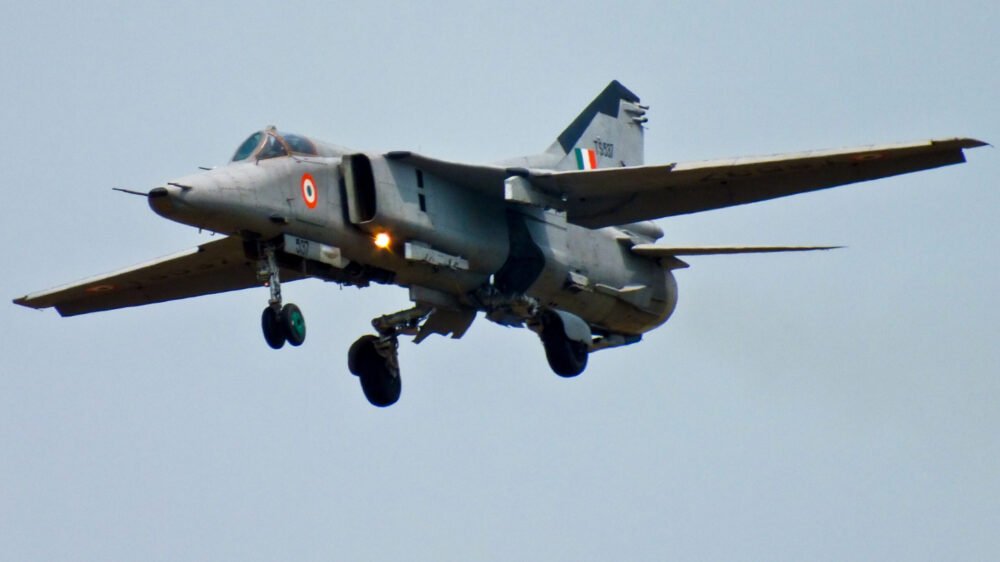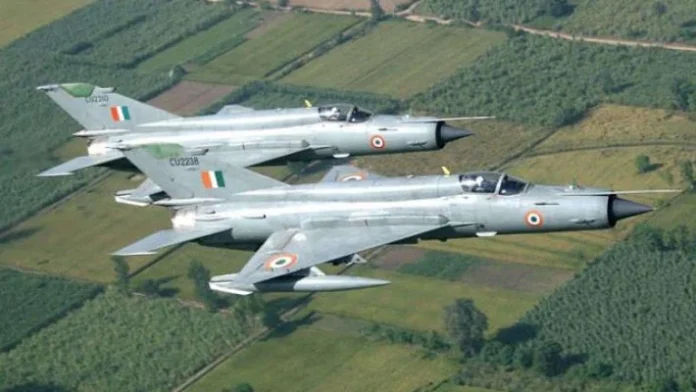the Indian Air Force (IAF) has lost hundreds of its finest pilots and airmen —over the past 50 years, not in battle, but in peacetime. The reason – aging fighter jets and transport crashes. Nearly 25% of the combat jets lost by the IAF were MiG-21s, followed by the Hunter F56 (10.2%), Vampire FB52 (8.9%), Tempest II (8%), Gnat (7.6%), MiG 27 (5%), and Jaguar (4.9%).
According to an estimate the IAF lost close to 700 aircraft – about 298 MiG-21, 59 MiG-27, 54 MiG-23, 25 MiG-29, and 4 MiG-25 which led to over 750 deaths of pilots in non-combat crashes since the mid-1970s. What this means is that the country lost more men and machines in so-called accidents during peace time than in wars.
Official records indicate the IAF lost 2,374 aircraft between 1947 and 2023. These included 1,126 fighters, 229 trainers, and 196 helicopter crashes leading to 1,305 pilot fatalities. In the last five years itself India has lost 42 aircraft – more than seven aircraft every year since 2020. This includes five aircrafts lost in 2020, 11 in 2021, five in 2022, eight in 2023, and eight in 2024 — all of them during routine peacetime missions.
MiG-21: the “flying coffin”
India is one of the largest operators of MiG-21 supersonic fighter jets being flown in about 60 countries. Since 1963, India has inducted more than 1,200 MiG-21s into its air force.
To date, more than 400 MiG-21 [Mikoyan-Gurevich (MiG)] aircrafts aptly called “flying coffin” have crashed killing more than 200 pilots – not in war but in peacetime which is why IAF plans to decommission all MiG-21s by this year end.
In 2012, then defence minister A K Antony informed the Parliament that out of 872 MiG aircraft purchased from Russia more than half were lost in crashes, killing over 171 pilots and 40 civilians. The numbers have only risen since then.
The MiG-21 has a documented history of a poor safety record as compared to other fighter aircrafts, due to mechanical failures and pilot error. Some of the significant flaws in the single-engine fighter jet include a cramped and uncomfortable cockpit, limited fuel capacity, high landing speed and primitive on-board radar.
The MiG-21 required high speeds — 360–380 km/h for take-off and 290–320 km/h for landing making it difficult to control at low speeds. Its cramped and uncomfortable cockpit and limited visibility from the canopy pose a significant challenge for pilots especially during landing and low-speed manoeuvres.
The MiG-21s were introduced in 1963 as interceptors, but eventually used to carry out ground attacks like other fighter aircraft. The MiG-21 with its high landing speed, antiquated ejection systems, and lack of advanced sensors was never ideally suited for training but that is exactly what it was used for in the 1990s and 2000s. Inexperienced pilots without much flying practice were tasked to fly the aircraft resulting in fatal outcomes during basic or intermediate training sorties.
One of the most tragic episodes occurred in 2002, when a MiG-21 crashed into a crowded bank located in a heavily populated residential and commercial area in Jalandhar, Punjab, killing eight civilians and injuring 17 people on the ground. The pilot, who ejected from the aircraft, survived but the IAF suspended all MiG-21 flight training operations after the crash.
A similar crash occurred on 14 June 1986, when the pilot of a MiG-21 ejected after taking off from an air base in Bareilly. The aircraft crashed into nearby Rampurmasi Village, killing 13 people on the ground. In another case in 2016, two pilots died after their MiG-21 failed to respond during a training sortie in Barmer, Rajasthan.
In 2021 Wing Commander Harshit Sinha died after the MiG-21 he was piloting crashed in Jaisalmer during a training sortie. In yet another incident, an Indian Air Force MiG-21 trainer crashed in Rajasthan in 2022, killing two pilots – Wing Commander M Rana and Flight Lieutenant Advitiya Bal.
In 2023 a MiG-21 fighter aircraft crashed during a routine training sortie near Suratgarh in Rajasthan. The pilot ejected safely and suffered minor injuries but at least three civilians were killed and as many were injured on the ground. According to the police statement, the pilot made all efforts to avert human casualties and crash-landed on the outskirts of a village.
The Indian Air Force (IAF) has lost hundreds of its finest pilots and airmen —over the past 50 years due to aging fighter jets and transport aircraft. Nearly 25% of the combat jets lost by the IAF were MiG-21s, followed by the Hunter F56 (10.2%), Vampire FB52 (8.9%), Tempest II (8%), Gnat (7.6%), MiG 27 (5%), and Jaguar (4.9%)
MiG-27 the “widow maker”
IAF was among the last Air Forces in the world to fly the Mikoyan MiG-27 – till the last squadron was formally decommissioned in air force station Jodhpur, Rajasthan, on December 27, 2019. Between 1985 and 1994 – the Indian Air Force was operating about 165 – nearly seven MiG-27 squadrons. The MiG-27 a Soviet-era ground-attack aircraft played a significant role in the Kargil War and earned the nickname “Bahadur” (brave)
However the MiG-27 had a poor safety record with a high crash rate per flying hour, even more than the MiG-21s. In mid-February 2010, India grounded its entire fleet of over 150 of the aircraft after a MiG-27 crashed on 16 February 2010 in Siliguri, West Bengal. The crash was attributed to defects in the R-29 engines of the aircraft.

The MiG-27 had one of the highest crash rates among IAF jets, especially in the 2000s. The Indian Air Force (IAF), lost six fighter jets in 2019 including the one piloted by Wing Commander Abhinandan Varthaman, which was shot down in the air duel over Pakistan-occupied Kashmir.
The concerns surrounding its safety record ultimately led to its retirement from the IAF fleet in 2019.
The MiG-27 earned the name “Widow Maker” because of its engineering flaws, maintenance troubles, and high crash rate that made it particularly dangerous to fly. Some of the key defects and flaws in the MiG-27 included its Tumansky R-29B-300 turbojet engine, which was extremely sensitive to throttle inputs. The hot, humid and dusty Indian climate further accelerated the engine wear and increased the risk of mid-air failure.
The K-36 ejection seat had a high minimum safe ejection altitude and was not always reliable in low-altitude emergencies. Several pilots died because they could not eject in time or the system failed to operate as expected. The jet required frequent maintenance, with long turnaround times and parts shortages. Many aircraft were cannibalised for spares, reducing fleet readiness.
The main drawback with the MiG-27 was that it was not pilot-friendly, especially at low altitudes and high speeds where it was intended to operate. Even a slight careless handling by an inexperienced pilot could lead to loss of control, engine stall or mechanical failure. The MIG-27 also had poor night-flying capability due to inadequate cockpit instrumentation.
Jaguar aircraft
The SEPECAT Jaguar, a twin-engine ground attack aircraft, known for its deep penetration strike capability, has been a critical part of the Indian Air Force (IAF) since the late 1970s. However the Jaguar fleet has also witnessed several crashes over the years due to technical failures, aging airframes, pilot errors, and external factors.
The main problem with the aircraft inducted in the 1980s and early 1990s is that most of the aircrafts are now over 30–40 years old. Even the spares are not easy to procure leading to maintenance challenges. As a result, some aircraft were flying well beyond their original design life, despite upgrades. Some of the other reasons behind Jaguar crashes in India:
Engine Failure: Jaguars use Rolls-Royce Adour Mk.804/811 engines, which reportedly suffer from engine flameouts and power loss during low-level flight.
Aging Airframes: Metal fatigue, corrosion, and structural wear increase the risk of mid-air disintegration or control loss.
Bird Strikes: Jaguars fly low and fast, making them more vulnerable to bird hits, especially near airfields.
Test Flight Accidents: Several crashes happened during post-overhaul sorties or test flights after upgrades, where system integration or undetected faults led to in-air failure.
Timeline of Recent jaguar crashes
March 7, 2025 (Panchkula, Haryana): A Jaguar IS crashed shortly after take-off during a training sortie. The pilot ejected safely, and no casualties were reported
April 2, 2025 (Jamnagar, Gujarat): A Jaguar crashed during a night training flight near Suvarda village. Two pilots were aboard; one ejected and survived, the other was killed
July 9, 2025 (Churu, Rajasthan): A twin-seat Jaguar trainer crashed during a routine flight from Suratgarh AFS. Tragically, Squadron Leader Lokender Singh Sindhu (32) and Flight Lieutenant Rishi Raj Singh (23) both succumbed to fatal injuries. Eyewitnesses say the pilot attempted to steer the jet away from villages before crashing
This was the third Jaguar crash, and IAF’s fifth peacetime crash in 2025. The IAF has set up courts of inquiry for each incident and recovered black boxes (e.g., for the July crash) to determine exact causes
Common factors across these crashes
Aging airframe & engines: All incidents involved Jaguars over 40 years old, still using legacy Adour Mk‑811 engines and original cockpit design
Lack of auto-ejection system: the absence of auto-eject meant pilots had to manually initiate escapes—often too late at low altitude
Low-level flying risks: These aircraft regularly operate at just 150 m altitude. Pilots have seconds to react to engine flameouts, bird-strikes, or control loss
What does this mean?
- Three Jaguar crashes within just six months raises serious concerns about fleet safety.
- The July crash particularly underscores the risks of manual ejection and ageing systems.
- The repeated accidents highlight the urgency to phase out Jaguars, still slated for service till 2035.
- Pending upgrades such as DARIN‑III avionics, AESA radar, and new ejection systems may not address core aging issues.
- Air Force leadership faces growing pressure to expedite newer platforms like Tejas Mk‑1A/2 and planned multirole combat aircraft
- Many fatal crashes in the early 2000s were due to control system failures and poor visibility during attack training.
Crash and Safety Insights
- MiG-21 stands out as the most accident-prone, with 400+ crashes and 200 pilot deaths, along with the highest loss rate (7.5 per 10,000 flight hours).
- MiG-27 also fared poorly with a high loss rate (5.8) and 40 fatalities despite fewer total aircraft.
- Jaguar, though significantly safer than the MiGs, still shows a moderate crash record with a loss rate of 3.8, mostly due to aging and engine issues.
- Mirage-2000 has had very few crashes, reflecting its high reliability, with a loss rate of just 1.5.
- Tejas emerges as the safest and most modern, with just 2 minor incidents and zero pilot fatalities so far.
To date, more than 400 MiG-21 [Mikoyan-Gurevich (MiG)] aircrafts aptly called “flying coffin” have crashed killing more than 200 pilots – not in war but in peacetime. In 2012, then defence minister A K Antony informed the Parliament that out of 872 MiG aircraft purchased from Russia more than half were lost in crashes, killing over 171 pilots and 40 civilians. The numbers have only risen since then
Not just fighters: Even helicopters and transport aircrafts go down
It’s not just fast fighter jets that fall from the sky. In 2016, an An-32 transport aircraft disappeared over the Bay of Bengal with 29 personnel on board—no one of them was found. Another An-32 crashed in Arunachal Pradesh in 2019, killing all 13 airmen. These incidents underscore the vulnerability of IAF’s transport fleet, especially in mountainous and remote areas with limited radar coverage and unpredictable weather.
Even more shocking was the Mi-17 V5 helicopter crash in December 2021, which claimed the life of Chief of Defence Staff Gen. Bipin Rawat, his wife, and 12 others. The official inquiry concluded that the crash was due to spatial disorientation caused by sudden cloud entry—an example of how high-profile tragedies can emerge from subtle lapses in visibility or terrain awareness.
Antonov An‑32 (March 7, 2025) – Crash Landing at Bagdogra: A twin-engine An‑32 performing a routine military transport flight made an emergency crash-landing near Bagdogra Airport (West Bengal) during the descent phase. The aircraft veered off the runway, with damage primarily to the right wing; there were no casualties among crew or passengers. A formal inquiry has been ordered to determine the cause of the landing accident
Mirage 2000 (February 6, 2025) – Crash near Shivpuri, Madhya Pradesh: A two-seat Mirage 2000 trainer jet experienced a system malfunction during a training sortie and crashed near Shivpuri. Both pilots ejected successfully, with no reported fatalities.
This was recorded as the 13th Mirage 2000 incident for the IAF since 1987
Looking ahead
Looking ahead, the Indian Air Force must accelerate the phasing out of obsolete platforms and prioritise the induction of modern, safer aircraft. Enhancing pilot safety is a moral imperative. Comprehensive reforms in maintenance, crew training, and crash investigation are equally vital. Every life lost in peacetime is a stark reminder that national security begins with safeguarding those who serve.
–The writer is a seasoned media professional with over three decades of experience in print, electronic, and web media. He is presently Editor of Taazakhabar News. The views expressed are of the writer and do not necessarily reflect the views of Raksha Anirveda






